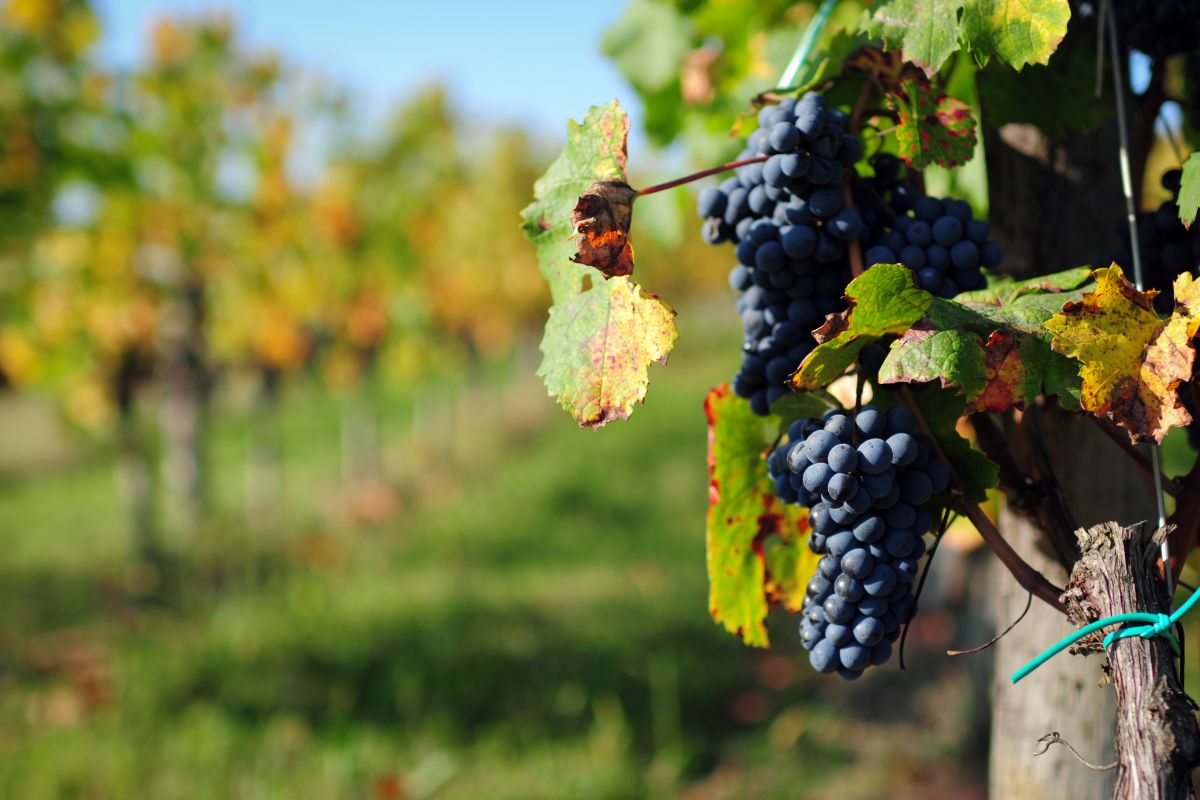When it comes to wines, there are few countries more famous for its production than France. The French have been responsible for numerous high quality wines in the past and they continue to do so.
Petit Verdot is one such French wine that has an intriguing profile and history.

It is an autochthonous red grape variety that hails from the southwest region of France – and plays a significant role in the production of classic Bordeaux cuvées from the Medoc.
Indeed, these grapes are used to provide more acidity and coloring to wines and give them more longevity and strength – but due to their small stature, the tannin content is high.
Of course, there’s a lot more you will need to know about Petit Verdot though, so we’ve written this complete guide which explains everything you could possibly think of!
Ready to learn more? Then read on and have all of your questions answered!
Petit Verdot: The Basics
Before we go on any further, we will give you a breakdown of Petit Verdot at a glance. These are the basics that you will need to know – and then later we will cover things in a lot more detail.
- Origins – France (southwest regions)
- Notable regions – Bordeaux, Australia, Argentina, California, Virginia
- Color – intense, deep and reddish/purple
- Berry skin color – rouge
- Flavor – dry
- Characteristics – full bodied, medium acidity and high tannins
- ABV – 13.5-15%
- Synonyms – Verdot Rouge, Petit Verdot Noir, Bouton, Carmelin and Petit Verdau
What Is Petit Verdot?
Now that we’re aware of the basics, it’s now time for us to dive into the guide in more detail. We will start by examining what Petit Verdot is.
Petit Verdot is a red grape variety of some classic Bordeaux varieties. While it has many other commonly known names like Verdot Rouge, it is much more commonly recognized as Petit Verdot.
A pure version of Petit Verdot is a red wine that is highly acidic with tannins – which is the reason why only small amounts of Petit Verdot are used in a blend. Examples of blends like this are Château Latour and Château Margaux.
In the nineteenth century, cultivating this red wine was very popular and a widespread activity throughout France. However, over the years, we have seen a huge decline in its population.
The wine ripens late and nowadays, it is more cultivated in the Bordeaux region, particularly so in Margaux. However, in addition to this area of France, you can find other producers of this wine, usually in hot climates.
These countries include Chile, Australia, Spain, Portugal, New Zealand, Argentina, South Africa and California in the United States.
Indeed, it is the late-ripening of Petit Verdot which is particularly noticeable – but so is its etymology.
Petit Verdot translates as “small green compact” which is indicative of its late ripening. In fact, they barely ever reach full ripeness before they expire.
Petit Verdot, Petite Sirah And Cabernet Sauvignon
Petit Verdot and Petite Sirah are totally different types of variety. Petit Verdot is much more acidic when compared with Petite Sirah and contains a much lower alcohol content.
Additionally, Petit Verdot is dominated more by its other flavors rather than being fruity.
These flavors include things like black cherry, plum, violet, sage and lilac. Petite Sirah on the other hand is much fruitier but also has additional flavors like black pepper, dark chocolate, black tea, sugar plum and blueberry.
The dry Petit Verdot is grown in many regions such as Australia, Spain, the United States, Italy and France – whereas Petite Sirah is more widely grown in the United States and Australia.
Now, while Petit Verdot and Cabernet Sauvignon are unrelated, they are used to blend together. Petit Verdot is responsible for the addition of color and tannins when it is blended with Cabernet Sauvignon.
As they often grow in the same regions of Spain, France and Australia, they share the same flavors of gravelly soils – likely due to the same climate that the grapes are grown in.
Characteristics Of Petit Verdot
The Petit Verdot grape variety gives a spicy wine which is full of aromas of fruits and violets, whilst also being highly tannic.
Indeed, as their name of “small green compact” suggests, they have high acidity and thick skins – leading to high tannins.
These grapes have a long vegetation cycle though, which means they take a long time to fully mature. If these grapes are harvested prematurely, they prove to be very difficult to digest.

When Petit Verdot is both in a bottle or in a glass, it shows a very strong, intense and dark red tone. While the acidity and tannin content is very characteristic of Petit Verdot, it is also well known for its alcohol content.
All of these excellent characteristics mean that the wine has a long shelf life, and if it is properly stored within a wine cellar, it can last for several years and continue to mature.
The Petit Verdot grapes are very frequently used for cuvées, and when combined – produces a much stronger wine. Yes, the grape enriches the mixture of varieties with its high content of tannins and superior acidity.
Petit Verdot Taste Profile
The color of Petit Verdot is dark and some people would say that it looks almost entirely black. It is also very concentrated, allowing for a bouquet that has pronounced balsamic notes, with minty chocolate and anise.
Its approach to your palate is balanced, yet determined – but it is certainly not aggressive. The fruits are well integrated into the wine and this provides a ripe, pronounced, stimulating wine with a high acidity level.
The tannins are spicy but they are also sweet and give you an amazing finish of complex spicy aromas and balsamic hints. Despite the fact that the wine is considered young, it has a very intriguing personality and remains balanced.
It, of course, changes depending on its storage and how it is matured. When it is aged with wood , Petit Verdot’s taste alters and becomes influenced by highly intense notes of plums, red fruits and blackberries.
However, other notes are identifiable such as vanilla, caramel and mocha. On the palate, you could describe it as meaty and fatty but with a good breadth. Luckily though, the wine remains balanced with its sweet tannins and acidity.
Petit Verdot Maturity And Aging
As many of you will already be aware of, the aging of wine happens naturally and can only take place after the wine has been bottled.
When we talk about aging and wine, it specifically refers to a positive process that enhances and improves the wine’s flavor and quality.
However, it’s important to remember that the opposite effect can occur. Sometimes, if the fermentation is too long – the wine can become impotable.
The period of aging is in reference to the overall time between fermentation and when the wine finally becomes impotable.
This is where the experience and knowledge of a winemaker comes into play, and this is the pinnacle of the art of winemaking.
A winemaker wants to use aging as a way to optimize the wine’s aromas, flavors and texture through natural chemical reactions – and this is a positive bottle aging.
The reactions are created by sugar, phenols and acids which create the wine’s overall bouquet.
Any experienced winemaker will be aware that the optimal time for Petit Verdot to mature and age comfortably is around ten years and this is because the tannins soften slowly.
Regions Of Petit Verdot
As we mentioned earlier, while Petit Verdot is originally from the Bordeaux region, it is now widely planted in other areas such as Australia, Peru, France, Spain and the United States.
Let’s take a look at some of these places in a little more detail.
Australia
Petit Verdot was included in the 1832 collection of James Busby, and was tested by Sir William Maccarthur around a decade or so later. Nowadays, Australia uses about four times more land for planting than France does.
You can find a whole host of Petit Verdot varietal wines around the South Australia region like Barossa Valley and Mclaren Vale.
Peru
In Peru, Petit Verdot’s vines are cultivated within the southern region of Ica. Due to its desert climate, Ica allows producers to make 100% varietal Petit Verdot wines.
Don Manuel is one of the most “high end” wines that Peru produces in the Tacoma winery.

France
As we know, most of the Petit Verdot grapes are grown in the Bordeaux region, specifically in Medoc where it is mostly used to create the well known structure of the Bordeaux blend. Having said this though, late maturing means that it takes only a few years to lose vintage.
This, along with the fact that it only ripens properly once every four years, means that it has fallen somewhat out of favor in this region. Of course, this is further the case because of the increasing popularity of earlier maturing wine.
Spain
Petit Verdot regions in Spain include Castilla La Mancha, Almansa, Mentrida and Jumilla. These regions offer a lot of the single varietal wines which are opaque and tannin rich. Typically, they are described as having notes of black pepper, licorice and black fruits.
United States
Primarily, Petit Verdot is grown in consistent climate states of America. Predominantly this is California where plenty of other wines are produced, but you can also find plants in Arizona, Texas, Virginia and New Mexico just to name a few.
Blends Of Petit Verdot
The word blend refers to the combination of any wine grape with another variety. It’s a method to make the wine taste better in terms of richness, brightness, texture and general quality. We’ve got some of the most popular blends below.
Circle Of Life Red Trocken (2017)
This is a red dry blend with fruity, ripe aromas and coconut notes on your palate. It has an amazing depth of flavors and it is highly impressive in terms of its intensity. This wine goes superbly well with red steak, pasta dishes and lamb.
Buezo Petit Verdot
With its 50/50 blend with Tempranillo, this wine has the perfect balance with an ideal acidity and alcohol percentage. It opens with a smooth entry, accompanied with a broad and a strong structure.
It also has perfect tannins with a persistent aromatic finish including the aromas of white pepper, chocolates and toast.
Petit Verdot DO (2019)
This is one of the most beautiful wines to look upon before you try it. It has an incredibly intensive ruby red color with some purple reflections. Its taste is described as being somewhat sour but with overtones of juniper and cinnamon.
The Bottom Line
And that’s everything you need to know about Petit Verdot. We hope this guide has been incredibly useful for you and you’ve found all the information you were looking for. Good luck on your wine journey!
Frequently Asked Questions
We will now cover some of your most frequently asked questions. We hope we can answer everything you still have on your mind.
This is a very important question and it’s not just about the temperature. You need to store Petit Verdot in a humidity of around 70%, and try to keep the temperature to around 17 degrees – which makes it perfect to drink.
Sausage, lamb, veal, pork and steak are all considered to be the perfect pairing with Petit Verdot. It really comes down to you, but consider red meats as your perfect option.
Petit Verdot is considered among one of the most high quality wines and it is aged for years prior to sale. As a result of these factors, you can expect to pay a relatively high price for this wine.
- Why Does Wine Taste Better With Age? - June 14, 2023
- What Does It Mean When A Bottle Of Wine Is Corked? - June 14, 2023
- Wine Fridge Vs Wine Cellar – Which One Should You Choose? - June 14, 2023
